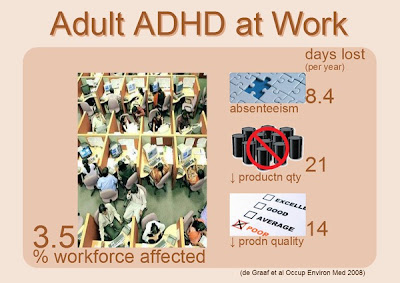ADHD (Attention Deficit Hyperactivity Disorder) is thought to be a childhood disorder. However ADHD persists in adults in up to 50% of children diagnosed with the disorder. Hyperactivity, impulsivity and inattention; the hallmark symptoms of Attention Deficit Disorder in childhood have been described earlier. In Adult ADHD, symptoms change to reflect the child's development into adulthood. The symptoms related to hyperactivity gradually disappear by adulthood; however, those related to inattention persist. Adults with attention deficit disorder (ADD) are often distracted, and avoid tasks requiring sustained mental effort. This impairs functioning at home and at work.
Adult ADHD at work
Adults with ADHD experience employment impairments at every level; from the initial job search, to the interview and then during the employment itself. People with Attention Deficit Disorder are more likely to be have poor job performance, lower occupational status, less job stability and absenteeism. Men and women with attention deficit disorder earn less money, and are more likely to be unemployed.Attention Deficit Disorder (ADD) has at times been portrayed as advantageous from a work perspective, as in the Economist, "in praise of misfits". This may be so in certain sectors where
This works for Attention Deficit Hyperactivity Disorder adults at the entry level of the IT industry. The physical, social and cultural environment help overcome functional limitations of adult ADD. However, the lack of focus, disorganisation and procrastination become evident when they are promoted in the organisation. It is at this mid-career stage that the adult with Attention Deficit Disorder seeks our help.
- Hyperactivity and distractability find an outlet in the need to multi-task with multiple apps at a time.
- Impulsivity manifests as risk taking and an apparent fearlessness.
ADHD friendly workplace adjustments
| Symptom | Adjustment |
|---|---|
| Inattention and impulsivity | Quieter room/positioning in office Flexi-time arrangement Headphones to reduce distractions Regular supervision to maintain course Buddy system to maintain stimulation |
| Hyperactivity/ restlessness | Allow productive movements at work Encourage activity Structure breaks in long meetings |
| Disorganisation, procrastination, and forgetfulness | Provide beepers/alarms, structured notes Regular supervision with feedback, mentoring Delegate tedious tasks Incentive/reward systems Regularly introduce change Break down targets and goals Supplement verbal information with written material |
Adult ADHD is a treatable medical condition. Medication to correct the underlying neurochemical imbalance is the cornerstone of treatment for ADHD adults. The adverse impact of adult ADHD is experienced by the employee and the organisation. At the organisational level, workplace adjustments can provide a safe nidus for the ADHD adult to function effectively. At the individual level treatment can help reduce the associated emotional problems and absenteeism of adult ADHD.
References
- Marios Adamou and colleagues. Occupational issues of ADHD adults. BMC Psychiatry 2013, 13:59 doi:10.1186/1471-244X-13-59
- Biederman J, Mick E, Faraone SV. Age-dependent decline of symptoms of attention deficit hyperactivity disorder: impact of remission definition and symptom type. Am J Psychiatry. 2000 May;157(5):816-8.
- de Graaf R, et al: The prevalence and effects of Adult Attention-Deficit/hyperactivity Disorder (ADHD) on the performance of workers: results from the WHO World Mental Health Survey Initiative. Occup Environ Med. 2008.
- Jane L. Ebeje, Sarah E. Medland, Julius van der Werf, Cedric Gondro, Anjali K. Henders, Michael Lynskey, Nicholas G. Martin, and David L. Duffy. Attention Deficit Hyperactivity Disorder in Australian Adults: Prevalence, Persistence, Conduct Problems and Disadvantage. PLoS One. 2012; 7(10): e47404. Published online 2012 October 10. doi: 10.1371/journal.pone.0047404
- Schultz S, Schkade JK. Occupational adaptation: toward a holistic approach for contemporary practice, Part 2. Am J Occup Ther. 1992 Oct;46(10):917-25.




